Food
Puerto Rico’s culinary heritage is a rich blend of indigenous Taíno Arawak, Spanish, African, and other Caribbean influences. It features a distinct blend of native seasonings and ingredients, setting it apart from Spanish and other Latin American cuisines. Locally, it is known as “comida criolla”.
Puerto Rico has some great dishes unique to the island, or that have a Puerto Rican twist that you should try during your visit. Food on the island is generally expensive with almost everything needing to be imported. Food in grocery stores is comparable to California prices. Average meals in restaurants cost somewhere between $14 and $25 you can find menu items much more expensive but not all that many that are less expensive.
When it comes to typical Puerto Rican food there’s a lot to try and not all of it will be for everyone. Many traditional foods are fried and healthy options aren’t common. I find that fruits (excluding avocado) and green vegetables are relatively hard to come by in most dishes. Here are some of my favorites you should give a try:

Puerto Rican Food
Main Dishes
Mofongo

A dish made of mashed fried green plantains mixed with garlic, olive oil, and chicharrones, often served with a meat or seafood filling or piled on top. You can also order a mofongo made from yuca, yellow plantains, or a combo of these three.
Lechón
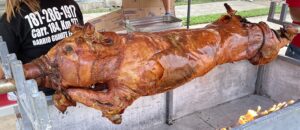
A roasted whole pig is often the centerpiece of a celebration and commonly eaten on Sunday morning/afternoon at lechoneras in the interior, although you can find it elsewhere. The best lechoneras are in Caguas and Cayey.
Chuleta Kan Kan
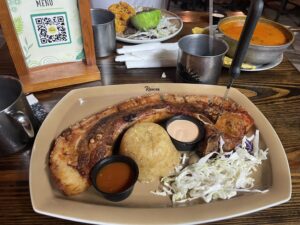
A massive fried pork chop with the skin left on. This is only for the most voracious of carnivores.
Pastelón de plátano
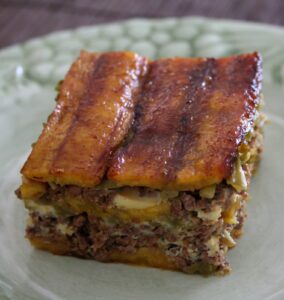
Puerto Rican pastelón is like lasagna but instead of pasta consists of layers of sweet plantains, ground beef that has been seasoned with sofrito (a blend of herbs and vegetables), tomato sauce, and cheese.
Seafood
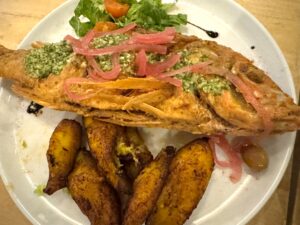
As you might imagine, there are a lot of seafood options. Try the catch of the day, it’s an island, after all. Whole, fried Red Snapper is by far the most popular seafood dish.
Sandwiches
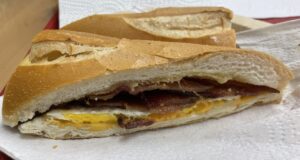
Sandwiches are popular in Puerto Rico and they are done well. Go to a panaderia and try a sandwich – whatever sounds good. I suggest bacon, egg, and cheese on pan sobao.
Asopao
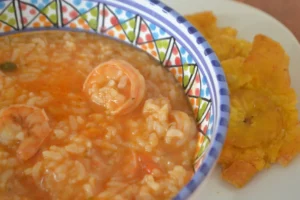
A hearty stew that contains rice. There are different versions of the stew, most commonly chicken and seafood.
Stuffed avocado
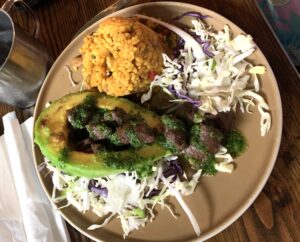
What it sounds like. The “stuffing” is your choice of meat or seafood.
Stuffed chicken breast

The chicken breast is commonly stuffed with chorizo and amarillos (sweet plantains), wrapped in bacon, and covered in a sauce.
Fried Pork
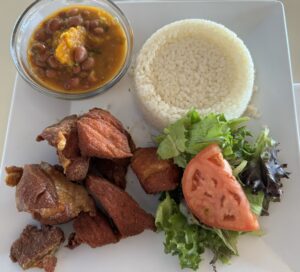
Fried pork (and sometimes onions) is what it sounds like. It’s chunks of pork seasoned and fried. This is usually one of the cheaper menu items.
Sides & Finger Food
Arroz con gandules
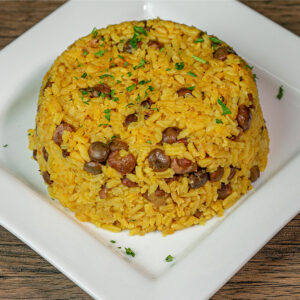
A rice dish cooked with pigeon peas, sofrito (a mixture of onions, garlic, peppers, and cilantro), and often ham.
Arroz Mamposteao
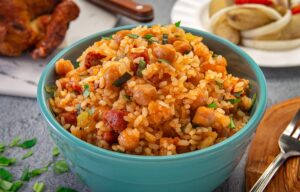
A Puerto Rican version of dirty rice, made with white rice, pork, beans, and sometimes vegetables.
Habichuelas
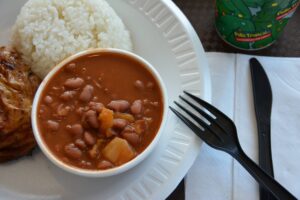
Beans. They’re good though!
Amarillos
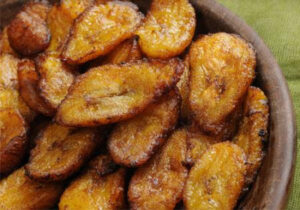
Fried sweet plantains. This is a versatile food that can be used for dinner or dessert. They’re often included in fusion food like sushi and hamburgers – I love it!
Tostones de platano & pana
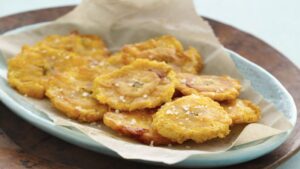
Twice-fried slices of savory green plantain or breadfruit. You’ll only find pana (breadfruit) if it’s in season, but it’s worth asking for!
Morcilla
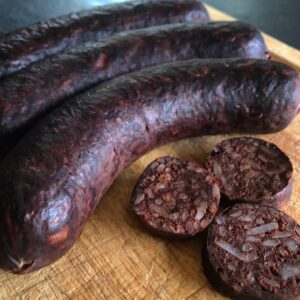
A sausage made from pig’s blood, rice, and various spices. Not all morcillas are made equal. Look for the plump ones that aren’t too shriveled.
Pastelillos
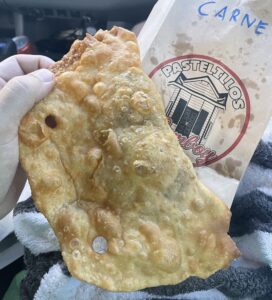
Deep-fried turnovers (basically empanadas) filled with different meats, fish, or crab. Sometimes even rabbit or iguana if you’re lucky! The one pictured is huge, but they are typically small.
Papa Rellena
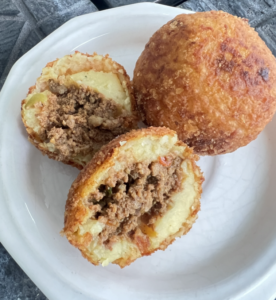
Mashed potato (or plantain or yuca) balls stuffed with meat and/or cheese and then deep-fried. These are a personal favorite of mine. I used to buy giant papas rellenas from a Colombian woman when I was living in Chile whenever I passed by her stand and I’ve never managed to find another quite as good.
Pionono
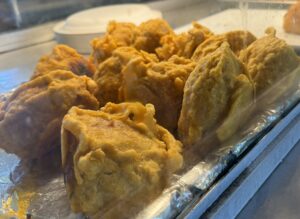
A core of chicken, beef, or seafood is surrounded by sweet plantain, dipped in batter, then fried. Piononos can be prepared in different ways, but the sweet plantains mixed with the savory meat filling is a winning combination in my book.
Sorullo
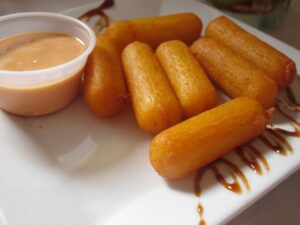
Fried cornmeal fritters, often filled with cheese. I’ve found that the quality of sorullos varies widely so if you try it once and don’t like it, consider giving them another try somewhere else.
Alcapurria
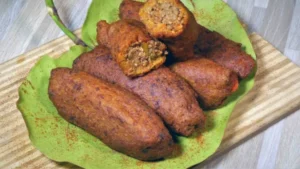
These fried logs don’t look particularly appealing, I know. Meat of some variety, typically corned beef, is surrounded by some kind of starchy dough, often plantain, then fried. They are not my favorite fried food, as the plantain can be overpowering for me. They are one of the most popular fried foods in Puerto Rico
Bacalaito
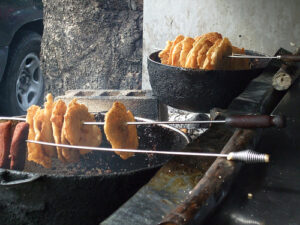
Cod is a popular fish in Puerto Rico and I think the bacalaito is its most interesting form. It’s a fried cod fritter usually resembling a large fried tortilla. They can vary in size greatly.
Arañita
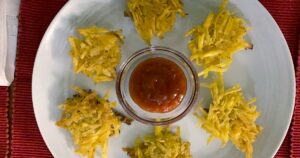
Similar to tostones, a green plantain is grated, assembled in a rough circular shape, then fried.
Batata Frita
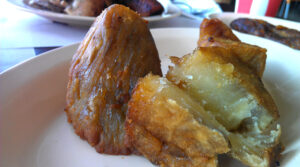
Fried sweet potato. This is one of my favorite sides to order. The sweetness balances out a plate of rice and pork or chicken nicely.
Pan Sobao

The most popular local bread looks like a loaf of French bread. It’s smooth, soft, and tastes slightly sweet. I love it, particularly when it is soft and fresh. Some bakeries will commonly cook the loaves until they are harder and drier than I like, so look for the soft ones.
Queso Frito

Fried cheese that is commonly dipped in guava sauce.
Tripleta

Tripletas are popular Puerto Rican sandwiches named thus for the three kinds of meat inside: cube steak (bistek), pork shoulder (pernil), and sliced ham.
Pasteles

Pasteles are typically made with pork and adobo stuffing encased in a green plantain masa and wrapped in banana leaves.
Chinchorreo
Chinchorreo is a fun culinary experience in Puerto Rico that combines a casual (or rowdy) road trip with a food/bar crawl. You’ll visit local bars or small restaurants. Chinchorreo is especially popular on weekends. Many people start their trip early in the afternoon and continue into the night. While there are a lot of possible routes all over the island, some of the best areas to explore are the 187 running along Piñones Beach , “The Lechón Road” in Cayey, and Los Kioskos de Luquillo. This website is a great resource for Chinchorreo routes.
During your visit, you might see pimped-out school buses driving around. These are expressly used to “chinchorrear”, you can rent out the full bus that seats around 40 people through an operator like Chinchorreo Bus, or take your own car. It’s common to sample different traditional finger foods like alcapurrias, bacalaitos, and pastelillos. When visiting chinchorros, it’s important to bring cash, as some of them don’t accept credit cards or might have minimum charges. Be prepared for lines, especially on weekends.
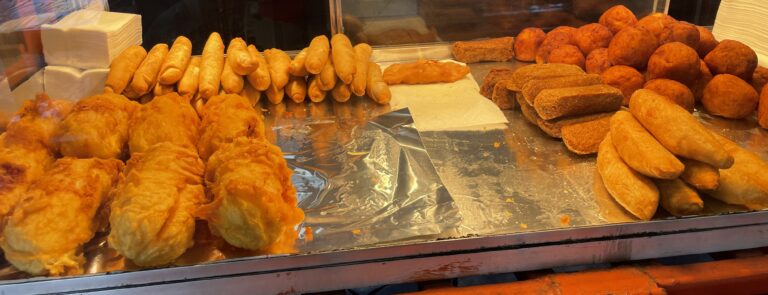
Lechoneras
Lechoneras are outdoor restaurants or food stands in Puerto Rico that specialize in roasted pig, known as lechón. Lechón is typically made by roasting a whole pig over an open flame, you’ll usually see it hanging in the front of the lechonera when you arrive. The person handling the lechón will slice off a hunk of meat and chop it into smaller pieces with something like a machete. The pig is cooked for several hours until the skin is crispy. Lechoneras are a popular destination on the weekend and can bring huge crowds.
Lechoneras can be found all over but some of the best ones are located in the towns of Guavate, Cayey, and Aibonito. Because of the lechón tradition in this area, the route through it is known as the “Pork Highway” or Lechón Road and is home to numerous lechoneras. Some popular spots include El Rancho Original in Guavate, Los Pinos in Cayey, and El Mojito in Aibonito. When you visit, you can expect to be greeted by the aroma of roasted pork and a lively atmosphere. Most lechoneras have outdoor seating areas where you can enjoy your food under a covered patio or open-air pavilion. The menu also includes sides like rice and beans, plantains, blood sausage, yuca, and fried finger foods.

Chinese Food
Most Chinese restaurants are pretty similar, stop at whichever one you come across. The first Chinese immigrants arrived in Puerto Rico during the 19th century, brought over as laborers to work on sugarcane plantations. Over time, Chinese immigrants established their own communities on the island, opening restaurants and businesses. A typical Chinese dish here includes your chosen main, fried rice, and fries, all in massive portions. It won’t be for everyone but I’m a fan. The boneless pork ribs and sweet and sour chicken are my favorites. Ask most any Puerto Rican and they’ll tell you that Chinese restaurants make the best mofongo and tostones.
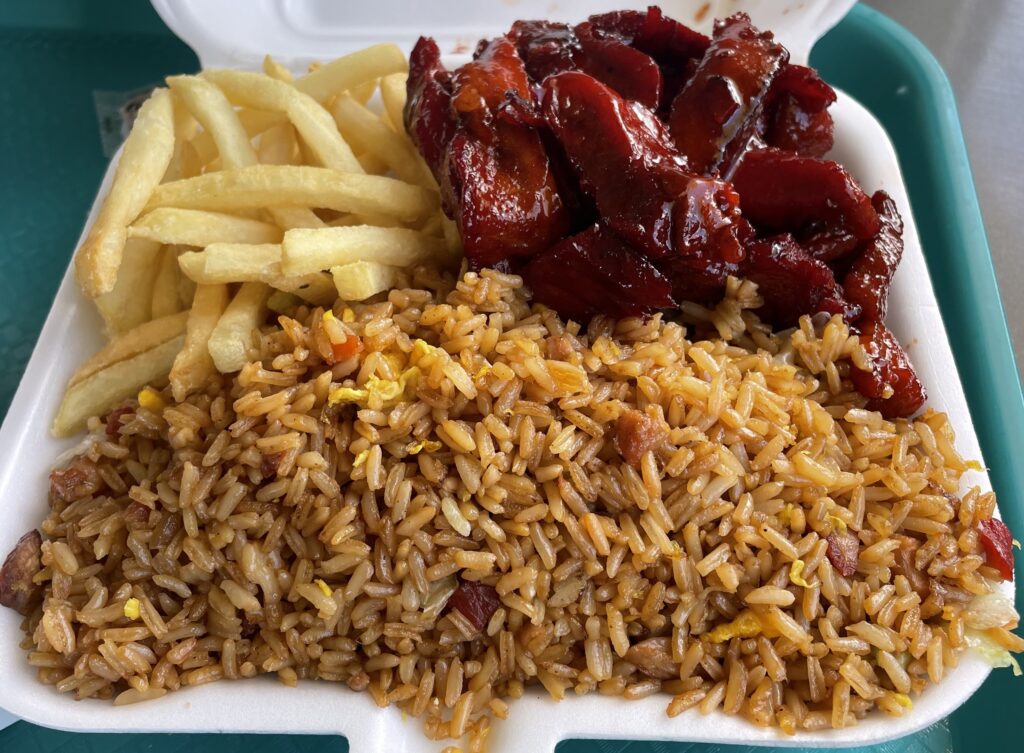
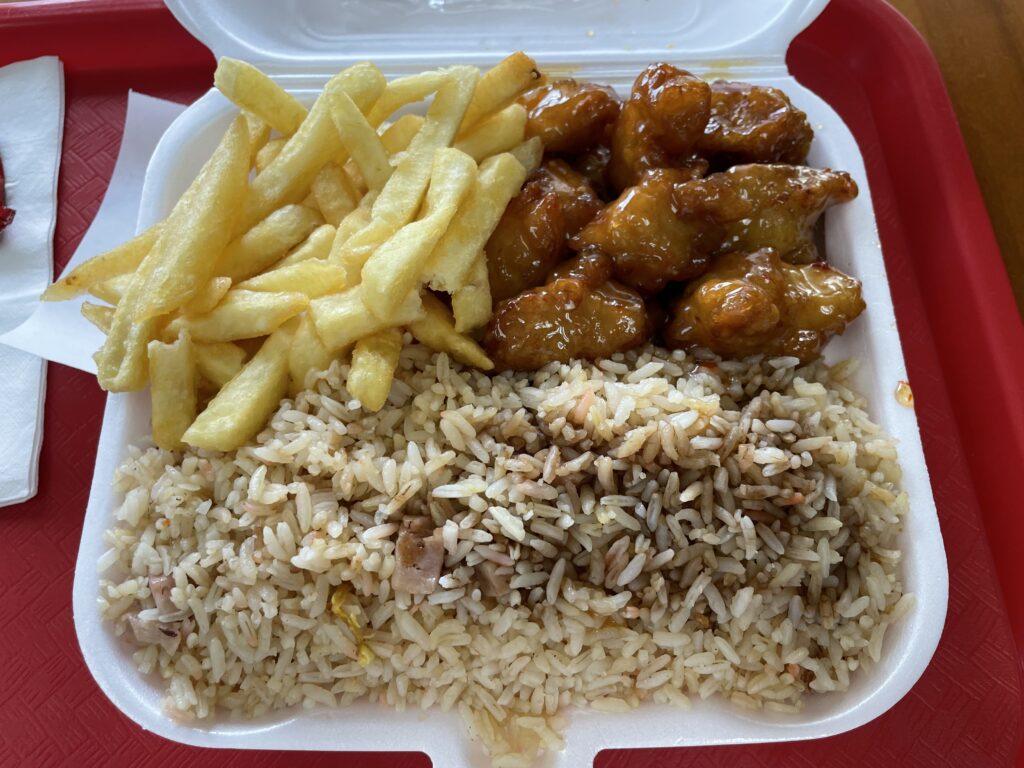
Seafood
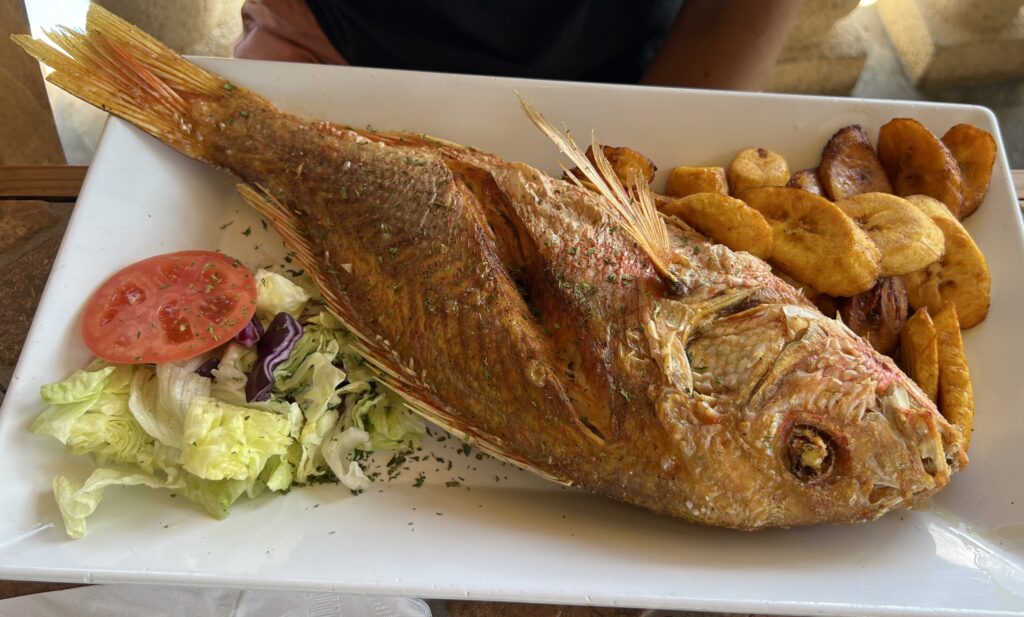
The most common seafood eaten in Puerto Rico may be red snapper. It’s commonly eaten whole and fried. Chapín (trunkfish) and grouper are also usually on the menu. Cod is eaten, often in the form of bacalaitos – a fried cod pancake of sorts. Lobster, shrimp, squid, and octopus are pretty easy to find. Fish tacos are less common but still present. Though, I don’t know of any place that serves fresh-caught fish battered and fried in-house.
Panaderías
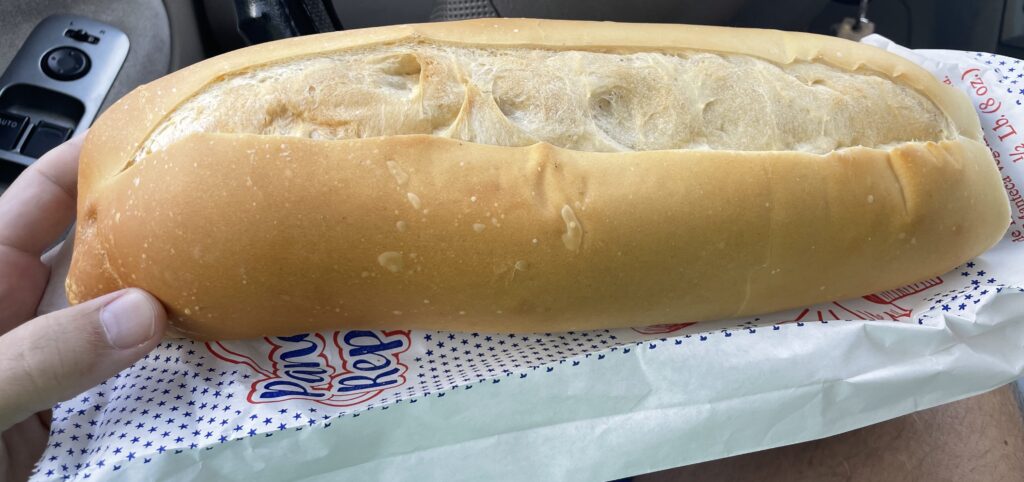
Most panaderías are pretty similar in what they offer and the quality of food, though there are standouts. Two varieties of bread are commonly available fresh every day, both look similar but one is slightly sweeter than the other. I prefer the sweeter “pan sobao” over “pan de agua”. Pastries, cakes, and sandwiches are usually sold at these bakeries as well. The bacon, egg, and cheese sandwich on pan sobao is my favorite breakfast item. Puerto Rican oatmeal is very good. I’m guessing there is a good amount of sugar added.
Local Produce

Bananas and plantains are the most plentiful local produce. Roots, avocados, mangos, coconuts, and breadfruit are also everywhere. You can find other locally grown produce like watermelon, pineapple, and lettuce in grocery stores. You may find wild passion fruit while hiking. Quenepas are a small citrus fruit with a large seed that is popular when in season, you’ll see them being sold on the side of the road. The municipality of Florida is known for its oranges (called chinas). Some fruits are not as well known in the states present here, like soursop. Soursop, or guanabana, is a large, spiky, green fruit with white flesh. It is best in smoothies or juices.
Dessert

Ice cream – I am told the ice cream commonly sold from vendors, who usually offer 3 flavors, is bought from the Dominican Republic. I love its consistency and flavor, more icy than creamy. Try a scoop of each but skip the rainbow. It tastes like play-dough. Buy from a vendor selling on the beach. Laying in the sand with coconut ice cream? Sublime.
Tembleque – a coconut pudding with cinnamon powder. The consistency is like creamy jello. This is a must-try.
Flan – A custard dessert with caramel sauce.
Frappés – Extremely popular on the island, with hundreds of businesses to choose from. Here, a frappé can be a smoothie or shake and most places will offer both versions.
